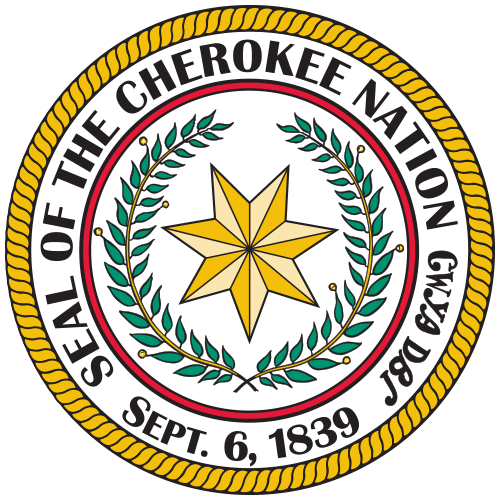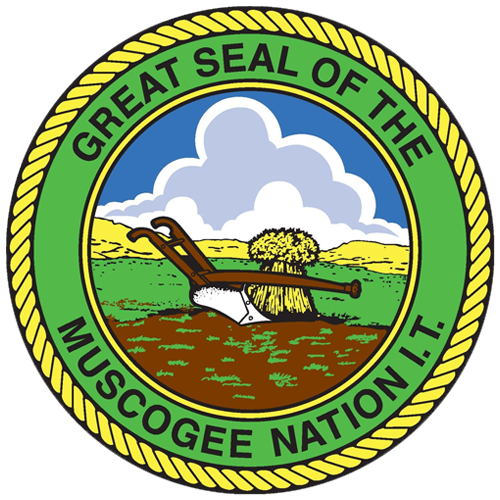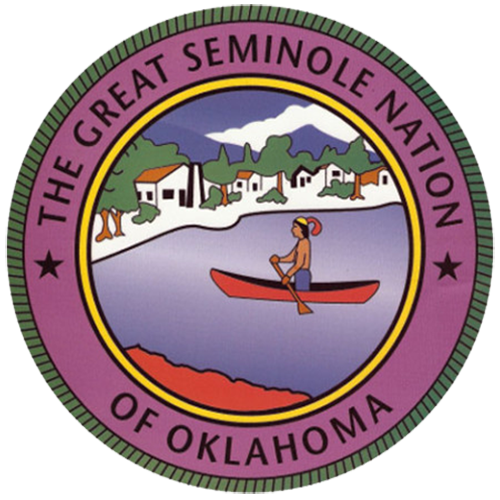




- Home
- Five Civilized Tribes
-
Council Documents
- Council Minutes
-
Resolutions
- Resolutions 1995
- Resolutions 1996
- Resolutions 1997
- Resolutions 1998
- Resolutions 1999
- Resolutions 2000
- Resolutions 2001
- Resolutions 2002
- Resolutions 2013
- Resolutions 2014
- Resolutions 2015
- Resolutions 2016
- Resolutions 2017
- Resolutions 2018
- Resolutions 2019
- Resolutions 2020
- Resolutions 2021
- Resolutions 2022
- Resolutions 2023
- Resolutions 2024
- Document Templates
Chapter One
Chapter One
Section One: Inter-Tribal Council Formation
As an earlier authority has written, “From the time the great nations of the Five Civilized Tribes, the Cherokee, Chickasaw, Choctaw, Creek, and Seminole, arrived in what is now Oklahoma, they have recognized the need to stand as a unit-a combined effort of strength. In a continuous endeavor, the Five Tribes have stood together to promote the welfare of all tribes and to support or oppose Indian related polices set forth by the United States Government, and other entities, and to promote inter-tribal neutrality among the other tribes.” Such diligent efforts by the Five Civilized Tribes resulted in the formation of the 1842 Inter-Tribal Council of the Deep Fork River, the 1861 United Nations of Indian Territory, the Okmulgee Council in 1866, and, most significantly, the establishment in 1949 of the Inter-Tribal Council of the Five Civilized Tribes (ITC).
Formed as a result of various meetings held in 1949 between various leaders and representatives of the Five Civilized Tribes, the Constitution of the Inter-Tribal Council clearly stated the objectives as follows:
- ··· to secure to ourselves and our descendants the rights and benefits to which we are entitled under the laws of the United States of America, and the State of Oklahoma; to enlighten the public toward a better understanding of the Indian race; to preserve Indian cultural values; to enhance and promote general educational opportunity among members of the Five Civilized Tribes; to seek equitable adjustments of tribal affairs; to secure and to preserve rights under Indian Treaties with the United States; and other-wise to promote the common welfare of the American Indians ····
During the second half of the decade of the 1970s and the early 1980s, much of the ITC’s considerations, like those of previous years, were centered around the subjects of housing, health, education, welfare, and the exploitation of Indian lands. Nevertheless, the leaders of the ITC in the years 1976-1991 would discover that they had to cope the complex new problems-such as those caused by the necessity of establishing new constitutions and tribal governments. Moreover, questions of sovereignty and the affected interrelationships with local, state and federal authorities would be exacerbated by a national recession triggering deep budgetary cuts in social, educational, and other federal assistance programs. Thus, while invested with greatly enhanced authority and responsibilities, leaders of the Five Civilized Tribes had to find solutions for many new perplexing complexities in the face of many adversities.
Section Two: Indian Health Service (IHS)
Never had the urgency to meet, discuss, and share problems and possible answers been more acute for tribal leaders than in the late 1970s and 1980s. As the subsequent story relates, the ITC demonstrated that they were prepared to protect and enhance the lives of the citizens of the Five Civilized Tribes. For example, always vigilant toward the welfare of their elderly, representatives at the October 1977 meeting applauded an agreement reached in September among the Indian Health Service (IHS), as well as the Department of Health, Education, and Welfare (HEW), and the Muscogee Nation through its Principal Chief, Claude A. Cox, securing IHS assistance for adequate water supply and waste disposal for a 100 unit Elderly Housing Project in Okmulgee County.
Besides efforts being conducted to provide better living conditions for the tribes; elderly, many encounters at meeting of the ITC in the late 1970s were about ways to provide the best possible health care for their citizens. One avenue selected was for the Council to lobby forcefully for a fair share of available federal funds for health services and the construction of medical facilities. In this sense, the ITC was tremendously successful. Under the leadership of Chickasaw Governor Overton James, President of the ITC in the late 1970s, the Council was able to enlist the support of Speaker of the House Carl Albert in convincing the IHS to build a new Indian Hospital in Ada. Opened in 1980 and later named in the Speaker’s honor, the Carl Albert Indian Hospital featured state of the art medical equipment.
While struggling for their share of available IHS controlled services, in the late 1970s representatives of the ITC debated about the advantages and possible disadvantages of the tribes contracting IHS services under Public Law 93-638 (PL93-638), the Indian Self Determination Act. In essence, basically the question to be considered was could the tribes provide better service if they managed all or part of their health care systems themselves. As a result of their deliberations, tribal leaders became convinced they should pursue this path. Still, most watched with apprehension as the Muscogee Nation became the first tribe to initiate contracting of various clinical services from their IHS under PL93-638. Before long, however, the Choctaws, led by Chief Hollis Roberts, would become the first nation to contract all clinical services within their territories, as well as those provided by the Talihina Indian Hospital.
In a related move to assure more equitable representation of their nations regarding health care, the Five Tribes also agreed in the late 19711s that it would be to their best advantage to withdraw from the Oklahoma City Indian Health Board; although they represented two-thirds of the total Indian population in the State of Oklahoma, they were only allowed a minority of votes on the Board. To better serve the Five Civilized Tribes, the Council established the Eastern Oklahoma Indian Health Planning Board, chaired by Governor Overton James of the Chickasaw Nation. Reporting completion of staffing to the ITC at its October 1978 meeting, Governor James announced that the executive director for the Board was to identify plans to assess the health care service needs of Indians in eastern Oklahoma by concentrating all efforts “toward effective communication between eastern Oklahoma Indian Health Providers, Indian Health Service Systems, agency, state, and Federal Health Systems.” Years later, the ITC would re-associate with the Oklahoma-wide Indian Health Board after being assured of a fully equitable presence for the Five Civilized Tribes.
Section Three: Housing and Urban Development (HUD)
To make certain their voices were well heard in the nation’s capital as well, delegates from the ITC accompanied the Principal Officers of the Five Civilized Tribes and the tribal Housing Authorities’ Directors for a trip to Washington in March 1979. At a meeting held on March 6, the ITC delegates, led by Council President Overton James, met with James A. Joseph, Under Secretary of the Department of the Interior, and Martin Seneca, Acting Deputy commissioner of the Bureau of Indian Affairs (BIA), to confer about issues “relating to the Bureau Affairs; Budget for the State of Oklahoma, matters of jurisdiction and taxation, and contract support funds under PL93-638.” Commenting on the importance of the visit, Joseph later said: “May I state it was a pleasure to meet with the leadership of the Cherokee, Chickasaw, Choctaw, Creek, and Seminole nations. I appreciate the opportunity for direct communication in our efforts to assist the tribes in resolving problems of mutual concern to the Indian tribes, this Department, and the Bureau of Indian Affairs.”
Because of their concern about housing funds, members of the ITC waited anxiously while the Principal Officers and the Executive Directors of the Housing Authorities met with Patricia Harris, Secretary of Housing and Urban Development (HUD), on March 8, 1979. In the past, unfortunately, funds that tribes had been unable to commit by the end of each fiscal year were reverted to the control of HUD, and, unless they were reallocated, the monies were lost to the tribes in their housing programs.
At the meeting, HUD officials were asked to make direct monetary grants to each tribe, rather than continue the practice of assigning a specified number of housing units per nation in each fiscal year. Such a request would allow each tribal Housing Authority not only to construct as many houses as funds would permit each year but also, should holdups occur, to assure that any leftover funds would remain under tribal control until the problems could be solved. Agreeing to consider the matter, HUD authorities further assured the tribal representatives that a HUD Indian Desk (an official) would be located in the Oklahoma City Area Office to facilitate Indian housing.
Although pleased at the reception they had received in Washington, ITC members soon became anxious, however, when rumors swept nationwide that the authorized number of 6,000 housing units was to be reduced drastically. Responding to this possibility, at a meeting at Tahlequah on July 13, 1979, the ITC passed a resolution stating:
- The Five Civilized Tribes ··· have participated in public housing since 1965 and ···have thousands of eligible families who have not been provided safe and decent housing because of limited allocations each year. ··· Now, Therefore be, it Resolved that the Five Civilized Tribes ··· representing more than 65,000 Indians, do hereby go on record as opposing the reduction of authorized units.
On the recommendation of Governor James, President of the ITC, a letter and copy of this resolution was sent not only to HUD and to national legislators but also to President Jimmy Carter. Within weeks of their action, to their satisfaction, the ITC was informed that the number of units would not be lowered. Such would not be the case, nevertheless, with the incoming presidential administration-but, that was for the unforeseen future.
Section Four: Economics
One other significant task the ITC tried to accomplish in the late 1970s was to inform the public of the many benefits the Five Civilized Tribes brought to life in the “Sooner State” in general. One such good opportunity occurred in 1979 when the ITC published a survey conducted by the Indian Rights Association of Philadelphia that vividly demonstrated the Five Civilized Tribes; strong impact on the economic status of the state. The study not only examined the flow of various funds produced and administered by tribes but also manifested the consequences that money ultimately had on local economies around the state.
In this publication the ITC pointed out, for example, that just one tribe, the Muscogee Nation, would spend in fiscal year 1980 $20 million developing various programs for tribal members. Most importantly, as the Council declared, “much of hat amount will go right back into the community through the spending of the tribe’s 1,500 employees.” Furthermore, the Council’s report stressed, “The myths of Indians not paying taxes has always been a problem; thus it is important to point out that Indians do pay federal, state, and local income and sales taxes.”